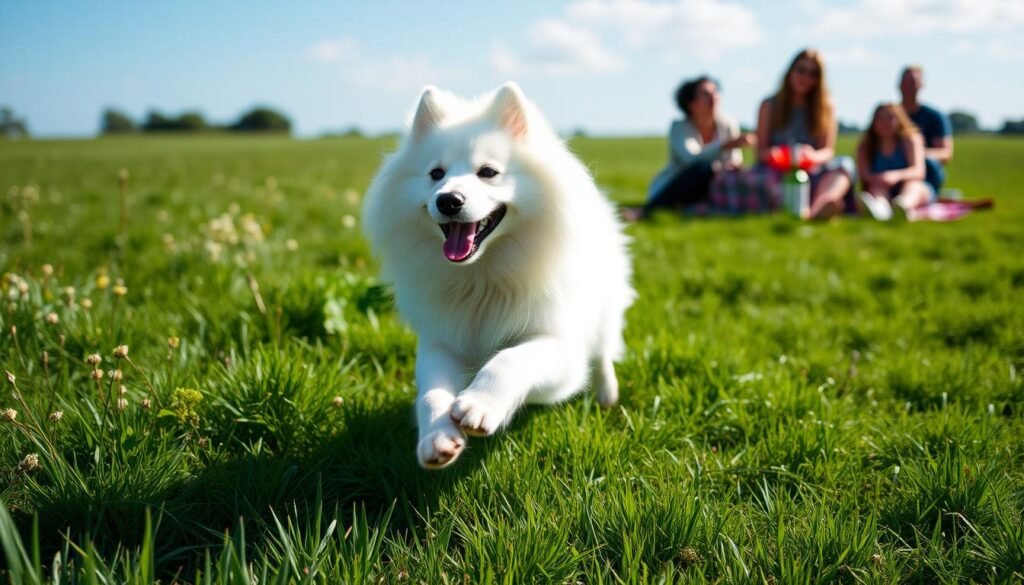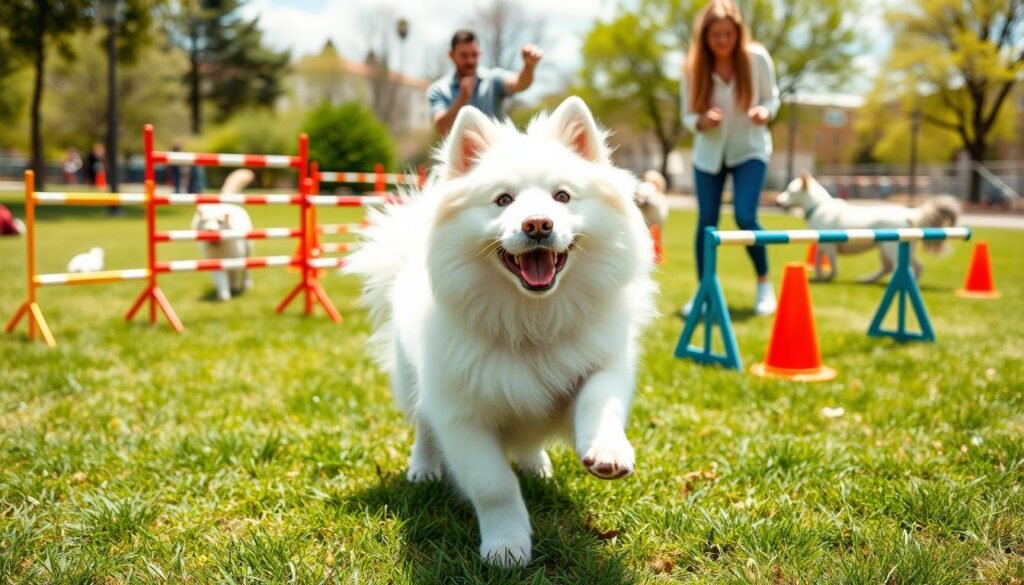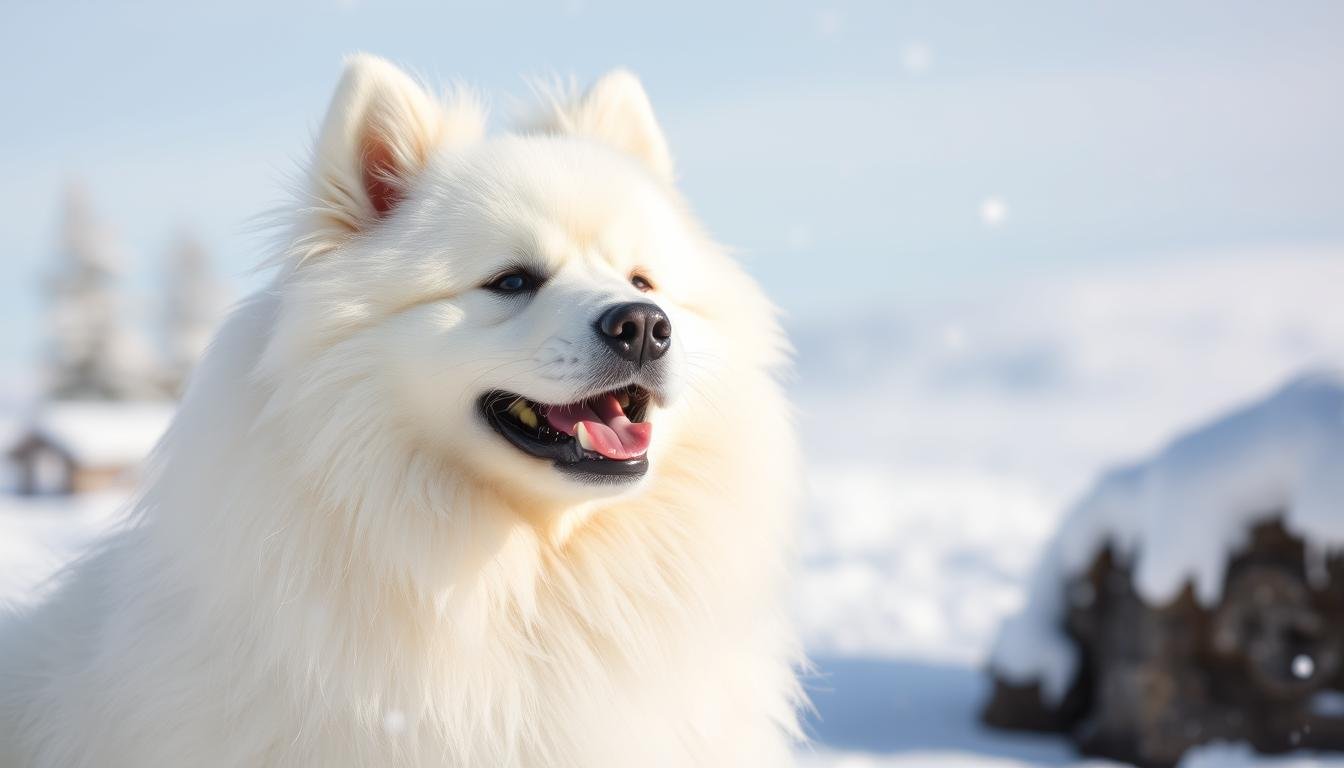I remember the first time a Samoyed melted my heart. It was a cold morning in the Lake District. A white ball of fluff came towards me, its tail wagging wildly.
This moment made me fall in love with Samoyeds. Millions in the UK feel the same. They are not just cute; they are full of history and warmth.
In this guide, we’ll explore Samoyeds from their Siberian roots to owning one. You’ll learn about their charm and working heritage. Discover why they’ve won British hearts and if they might win yours too.
Key Takeaways
- Samoyeds come from Siberia’s cold, bred by the Samoyedic people
- Their double-layer coat needs regular grooming
- They are smart and love people
- They need daily exercise for their health
- Training helps them behave well
The Fascinating History of Samoyed Dogs
Exploring the history of Samoyed dogs is like opening a book on the Arctic. They didn’t just pop up in homes. Their journey started over a thousand years ago, driven by survival and friendship.
Origins in Siberia
The Samoyed’s story begins in Siberia’s icy lands. The Samoyedic people created them as all-around friends. Unlike other Arctic dogs, they did more than pull sleds.
They herded reindeer, watched over camps, and even kept families warm at night. Their thick fur was key to surviving colds below -30°C.
“Their endurance and gentle nature made them irreplaceable. A Samoyed wasn’t merely a tool – it was family.” – Early 20th-century polar explorer Robert Falcon Scott
Working Heritage
Samoyed dog info often talks about their role in polar adventures. They helped explorers like Fridtjof Nansen cross icy lands. But their biggest role was in Siberian life.
They did many things, like:
- Guarding against wolves and bears
- Herding semi-wild reindeer without aggression
- Providing heat through shared sleeping arrangements
This made them smart and team players.
Journey to Modern Times
Queen Alexandra fell in love with Samoyeds in the 19th century. They won over the British with their white coats and happy faces. The Kennel Club welcomed them in 1909.
Today, Samoyeds keep their ancient strength. They connect Siberian nomads with today’s dog lovers.
Knowing about Samoyed dogs means seeing their old-world spirit and modern charm. Their history is in every happy tail wag and watchful eye.
Physical Characteristics of the Samoyed Breed
Samoyeds have a unique, fluffy look. Their thick coat keeps them warm. Males are 45–65 pounds, and females are 35–50 pounds.
“A Samoyed’s smile is as iconic as their coat—their upturned lips prevent drooling in freezing temperatures.”
Samoyed dog information highlights their special coat:
- Double-layer: A soft undercoat and harsher guard hairs.
- Colour: They are white, cream, or biscuit, shining in sunlight.
- Maintenance: Brush them weekly to keep their coat shiny.
| Trait | Male | Female |
|---|---|---|
| Height | 21–23.5 inches | 19–21 inches |
| Weight | 45–65 lbs | 35–50 lbs |
| Coat Length | Medium-long, dense | |
Samoyeds have almond-shaped dark eyes and erect ears. They are agile, thanks to their muscular build. Their small paws help them move on snow.
Their fluffy tails curl up when they’re alert. This makes them look happy. Their looks and abilities make them special.
Samoyed Dogs 101: Everything You Need to Know About This Fluffy Breed
When I first saw samoyed dogs, I was amazed. They are called “smiling sled dogs.” These dogs are both beautiful and useful. Let’s learn about samoyed dogs 101, including their looks and care.
Size and Weight Guidelines
Samoyeds are medium-sized but strong. Males are 20–23.5 inches tall and weigh 20–30 kilograms. Females are a bit smaller. Their strong build shows their working background, mixing strength with quickness.
Coat Types and Colours
The samoyed breed has a special coat for cold weather. It has:
- A thick undercoat for warmth
- A long, tough outer coat that keeps dirt off
- Colours like pure white, biscuit, or cream
“A well-maintained Samoyed coat isn’t just beautiful—it’s a sign of their health. Regular brushing stops matting and keeps their glow.”
Distinctive Features
Samoyed dogs have special traits:
- The “Sammy smile”: upturned lips stop drool icicles in cold
- A plumed tail that curls over the back
- Almond-shaped dark eyes that show their smartness
Knowing these things about samoyed dogs 101 helps owners meet their needs. From keeping their coat right to understanding their looks, every detail is important for caring for this special breed.
Understanding Your Samoyed’s Temperament

Samoyeds are full of joy and energy. They are playful and loyal, making great friends. Let’s look at what makes them special to help you connect with them.
Social Nature and Family Life
Samoyeds love being around people. They fit well into families and get along with kids. Their history shows they don’t like to be alone.
They can get anxious if left by themselves for too long. Playing with them regularly and including them in family activities keeps them happy.
Intelligence and Training Capacity
Samoyeds are smart and can learn quickly. But, they might test the rules sometimes. Use treats or praise to encourage them.
Being consistent helps avoid stubbornness. Socialising them early helps them get along with other pets and places. Patience is key—they do better with kindness than harshness.
“A well-trained Samoyed is a happy Samoyed. Their eagerness to please makes training rewarding.”
Common Behavioural Traits
Knowing about samoyed dog information helps you understand their quirks. They like to talk and bark a lot, even when they’re just playing. They also have a habit of digging, which they learned from their ancestors.
Make sure to give them a place to dig, like a sandbox. Some key traits include:
- High energy levels requiring daily exercise
- Chewing tendencies when bored
- Strong prey drive around small animals
With the right care, these fluffy friends can be wonderful family members. Knowing their needs helps create a happy home.
Essential Grooming Tips for Your Samoyed
Keeping a Samoyed’s coat clean needs a lot of work. Their thick fur needs daily care to stop mats and tangles. I’ve learned that being consistent is very important.
First, get the right tools:
- A slicker brush to remove loose undercoat
- A wide-toothed comb for detangling
- Grooming scissors with rounded tips for safety
“Bathing a Samoyed every 6–8 weeks keeps their coat bright without stripping natural oils. Always use a whitening shampoo formulated for double-coated breeds.”
Pay extra attention to areas that easily mat, like behind the ears and under the legs. Brush twice a day during shedding season to control the “Samoyed snowstorm.” Also, don’t forget to trim nails and check ears regularly.
| Task | Frequency | Tools Needed |
|---|---|---|
| Brushing | Daily | Slicker brush, comb |
| Bathing | Every 6–8 weeks | Whitening shampoo, conditioner |
| Nail Trimming | Monthly | Dog nail clippers |
| Ear Cleaning | Bi-weekly | Vet-approved ear solution |
For tough mats, don’t pull hard—use detangling spray and be gentle. Think about getting a pro groom every 3–4 months for deep deshedding. A well-groomed Samoyed is not just pretty; it’s also healthier and happier.
Exercise Requirements and Daily Activities
As a Samoyed owner, I’ve learned to balance their physical and mental needs. They love to play and work. Here’s how to keep them happy and active.
Physical Exercise Needs
Samoyeds need at least 30 minutes of vigorous exercise daily. They were bred to pull sleds, so they need to stay active. Here are some fun ways to keep them moving:
- Brisk walks or jogs in cooler hours to avoid overheating.
- Off-leash play in secure areas, leveraging their love for running.
- Interactive games like fetch, which align with their retrieving instincts.
“A tired Samoyed is a happy Samoyed. Their energy mirrors their history – channel it wisely, and you’ll have a well-adjusted companion.”
Mental Stimulation
Samoyeds are smart and curious. Without mental challenges, they might dig or chew. Here are some ideas to keep them busy:
- Puzzle toys filled with treats to reward problem-solving.
- Obedience training sessions, keeping drills short and upbeat.
- Hide-and-seek games using scented toys to engage their senses.
Recommended Activities
Try different activities to keep them happy. Here are some ideas:
- Hiking on wooded trails, allowing exploration.
- Agility courses to test coordination and focus.
- Swimming in shallow waters during warmer months (supervised).
Make sure to adjust activities based on your dog’s age and health. This keeps them excited and engaged. A mix of physical and mental activities is key to a happy Samoyed.
Health Considerations for Samoyed Dogs
Owning a Samoyed means caring for their health. These dogs are full of life. Knowing about health issues helps keep them lively.
Proactive care is key. This includes diet and vet visits.
Common Health Issues
Samoyeds are usually healthy. But, some problems are common:
- Hip dysplasia, a joint issue affecting mobility.
- Progressive retinal atrophy, which can lead to vision loss.
- Hypothyroidism, impacting metabolism and energy levels.
Early detection is important.
Preventive Care
Regular vet visits are a must. My vet says:
“Samoyeds thrive with preventative care. Annual blood tests, dental cleanings, and parasite control are foundational.”
Other steps include:
- Brushing their double coat weekly to prevent matting.
- Providing joint supplements if recommended.
- Keeping up with vaccinations and flea treatments.
This care ensures a long, healthy life.
Lifespan Expectations
The samoyed breed lives 12–14 years. With good care, some live up to 16. Genetics matter, but love is key.
I’ve seen how small efforts make a big difference. It leads to a happy, healthy dog.
Training Your Samoyed: Tips and Techniques

Training a samoyed can be fun and hard. They learn fast but need a special way to learn. They like knowing what to do next, like going potty outside.
“Positive reinforcement isn’t just a method—it’s the cornerstone of building trust with your samoyed.”
Begin with simple commands. Give treats or praise when they do well. For potty training, take them out often, like after eating or sleeping.
If they have accidents, don’t worry. Keep trying. If they get stubborn, keep lessons short and fun. They need to think and move around too.
- Use high-value rewards like chicken or cheese during samoyed training.
- Practise commands in different environments to reinforce learning.
- Address barking or digging early with distraction techniques.
Changing bad habits needs creativity. Samoyeds like to be with people, so don’t leave them alone. If they chew on things, give them a chew toy instead.
Always be kind to your samoyed. They can get hurt if you’re too hard on them. Work together and you’ll make a strong bond.
Nutrition and Dietary Requirements
Knowing what your samoyed eats is key to their energy and fluffy coat. They need a mix of protein, fats, and nutrients. Let’s look at how to keep them healthy.
Recommended Food Types
Choose high-quality dog food. Look for:
- Animal protein sources like chicken, lamb, or fish first.
- Healthy fats like salmon oil or flaxseed for skin and coat.
- Less fillers (corn, wheat) to avoid tummy troubles.
Feeding Schedule
| Age | Daily Meals | Portion Size* |
|---|---|---|
| Puppy (2-6 months) | 3-4 | 150-200g |
| Adult (1-7 years) | 2 | 250-300g |
| Senior (8+ years) | 2-3 | 200-250g |
*Adjust based on activity level and vet advice.
Special Dietary Considerations
- Watch for food allergies—some samoyeds don’t like grains or poultry.
- Use vet-approved supplements like glucosamine for joints.
- Avoid overfeeding to stop obesity, which hurts their active lifestyle.
Customising meals for your samoyed ensures they stay healthy, from puppy to old age.
Conclusion: Is a Samoyed the Right Dog for You?
Choosing a dog is like picking a new family member. After diving into samoyed dog information, you might wonder if this fluffy companion suits your lifestyle. Their unwavering loyalty and playful spirit make them ideal for active households. Yet, owning a samoyed breed requires dedication to grooming, exercise, and mental engagement.
If you love your furry friend but work long hours, consider their social needs. Samoyeds thrive with companionship and dislike solitude. Families with gardens or access to parks will find their energy infectious. For urban dwellers, daily walks paired with puzzle toys from brands like Kong can keep them stimulated.
Health-conscious owners should prioritise regular vet check-ups and quality nutrition. Brands like Royal Canin or James Wellbeloved offer tailored formulas for double-coated breeds. Their iconic white fur demands weekly brushing – a small price for that dazzling smile.
Ask yourself: can you commit to 12+ years of snowy tumbleweeds and endless affection? If your answer is yes, the samoyed breed might just be your perfect match. Their joyful presence transforms homes, proving that effort reaps endless rewards. Ready to welcome a cloud with paws?

http://Winston
Winston here from Iowa. I’m always watching for new sites and looking at older ones and thought I’d reach out to see if you could use a hand driving targeted traffic, automating repetitive tasks, or some good old fashioned bulk targeted outreach campaigns to lists I already own.
I’ve been doing this for over 20 years — building sites, editing videos, crafting bulk email campaigns (I even provide the targeted lists as I mentioned), running traffic, creating custom software, fixing and optimizing WordPress sites, I’ll even pay for any plugins you might want/need. If a solution exists, I’ve probably built it or bought it — and if I haven’t, I will for your project. I’m happy to shoulder 90% of the cost with tools, lists, licenses, and tech I already own.
All I ask is a flat $99/month for my time, month to month — no catch. I don’t mean to impose, I just wanted to offer real help if you’re open to it.
Quick background: born and raised in the Midwest, married, three girls. If I can support them by helping you using everything I’ve built over the years, that’s the kind of win-win I can imagine. It still amazes me how few people actually help the way I do — and I’d love the chance to show you.
If you need anything at all, just ask, doesn’t cost anything to do that.
P.S. – If I missed something you might need help with, just ask. I only scratched the surface here.
All the best,
Winston
Cell: 1-319-435-1790
Chat with me anytime: https://kutt.it/deserve